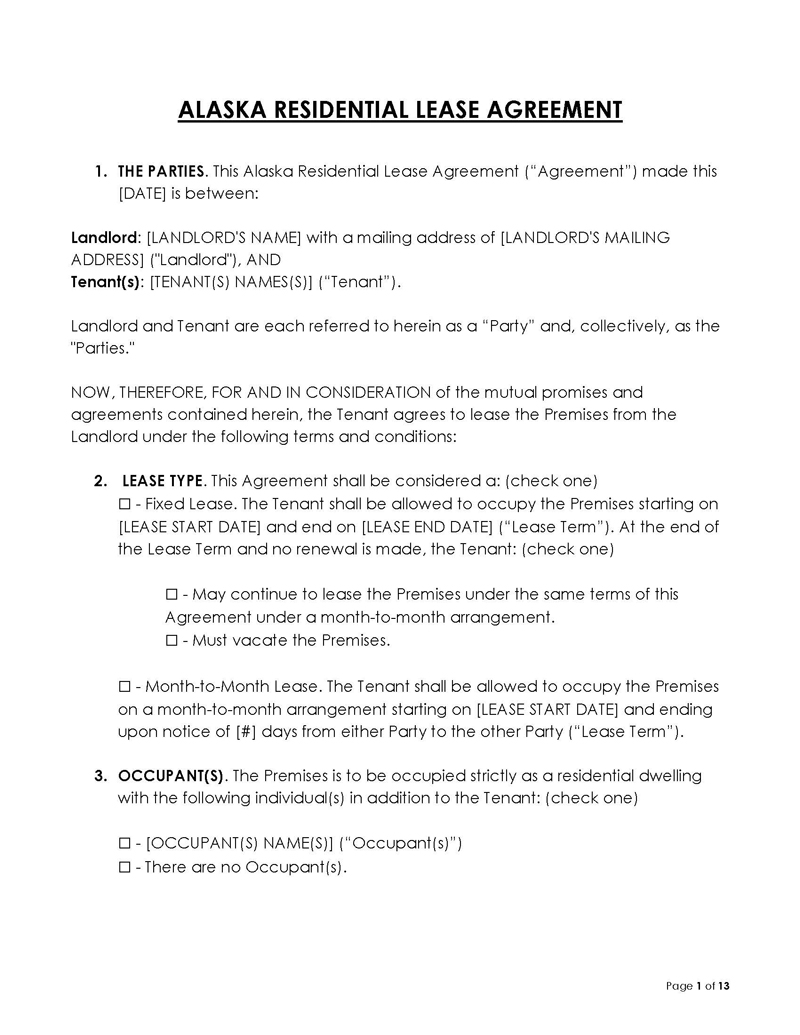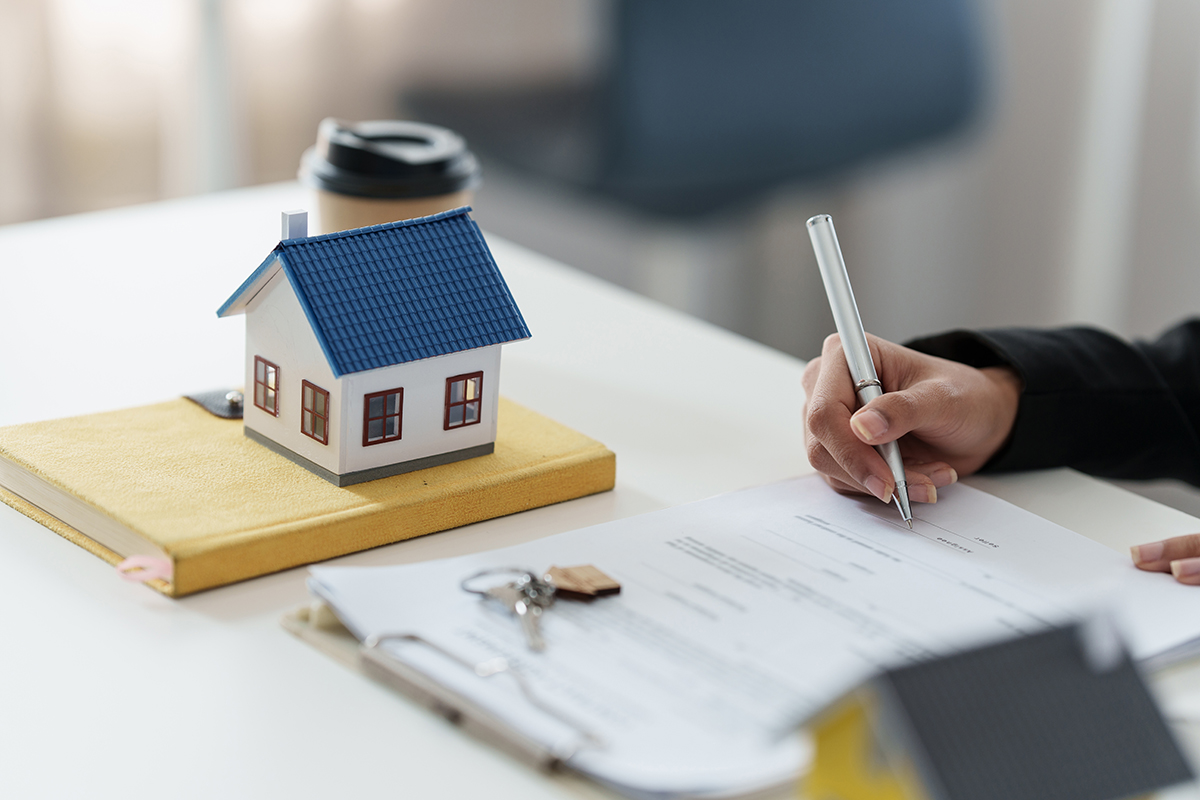A lease agreement in Alaska is a legal contract that provides a pathway for a property owner to rent out different types of property to a potential tenant, stipulating a specific monthly compensation.
Typically, this type of document can be created after meeting with the renter and speaking about the conditions of the agreement.
After checking for various elements like the tenant’s proof of income and a lack of a criminal background, the landlord can present a lease agreement in Alaska that states all the terms that both parties must abide by. Once both parties sign the agreement, the tenant has the legal right to reside on the property during the established timeframe. This type of agreement can be used for different properties, such as residential or commercial.
Alaska Lease Agreement Types
There are many different types of lease agreements available in Alaska. These distinct documents are essential to clearly understand the terms and conditions of the tenant’s right to take possession of the property.
Here are some of the most common types:
Commercial lease agreement
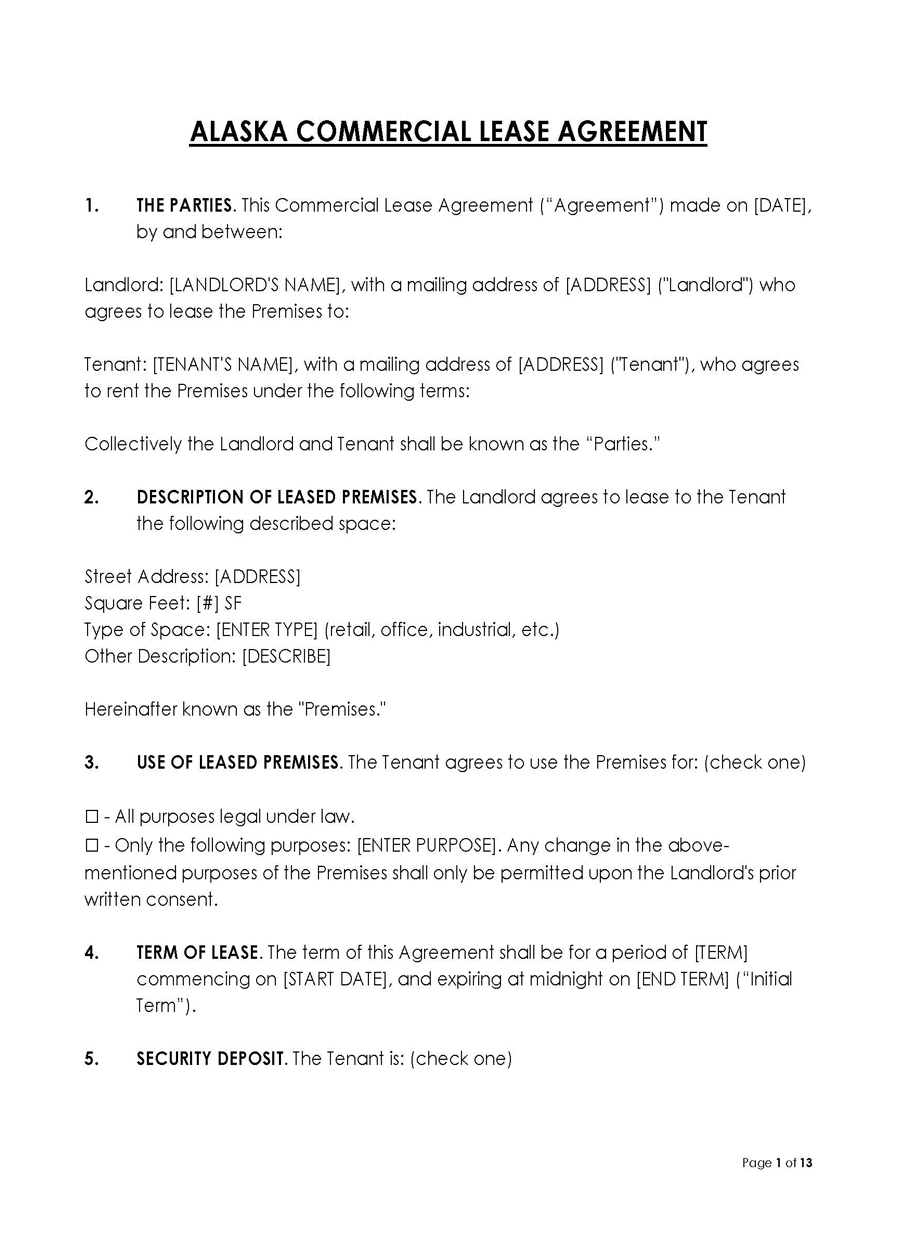
The commercial lease agreement is a specific document used to rent out space primarily for business purposes in Alaska. This could be anything from office space to a restaurant to an industrial building. It must always contain all the specifics regarding the proceedings, such as the duration of the lease, monthly rent, any security deposits, and any penalties. It should also specify whether any changes to the building itself can be made and if there are any monetary reimbursements necessary.
Month-to-month lease agreement
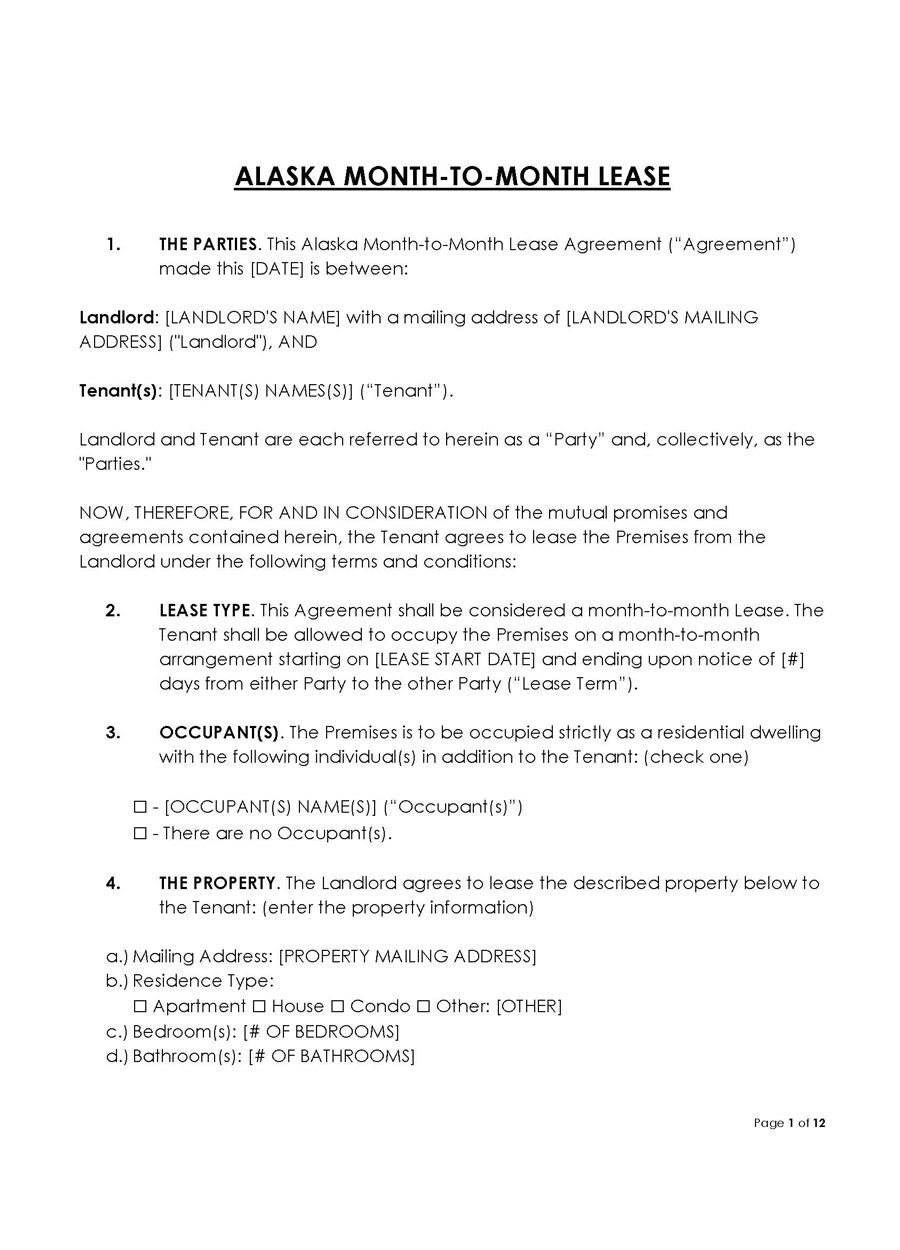
A month-to-month contract is a lease agreement with a period that renews monthly in Alaska. This allows the tenant and the property owner to end the lease within 30 days. During this month-to-month agreement, the landlord also has the right to increase the rent or change any conditions, as long as the tenant is given appropriate notice.
Rent-to-own lease agreement
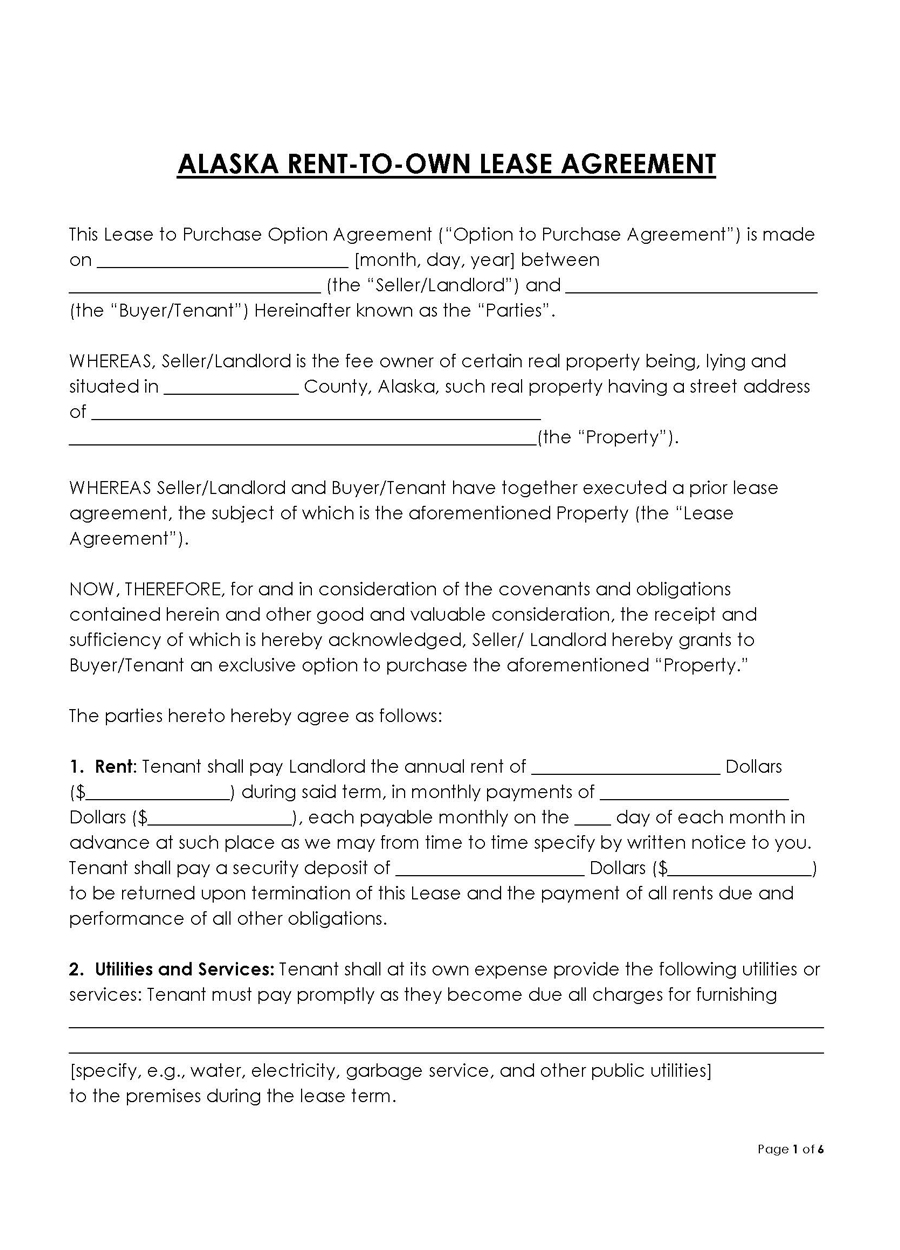
A rent-to-own lease agreement in Alaska is a unique agreement that gives the tenant the option to purchase the property. However, it is a much more complicated rental agreement, as the terms and conditions of the purchasing process must be laid out in the original contract. The tenant is not obligated to purchase the property, but if they so decide, the two parties will convert the lease into a purchase agreement after a given amount of time. If the tenant does not choose to buy it, the contract will end like a standard agreement.
Room rental (roommate) agreement
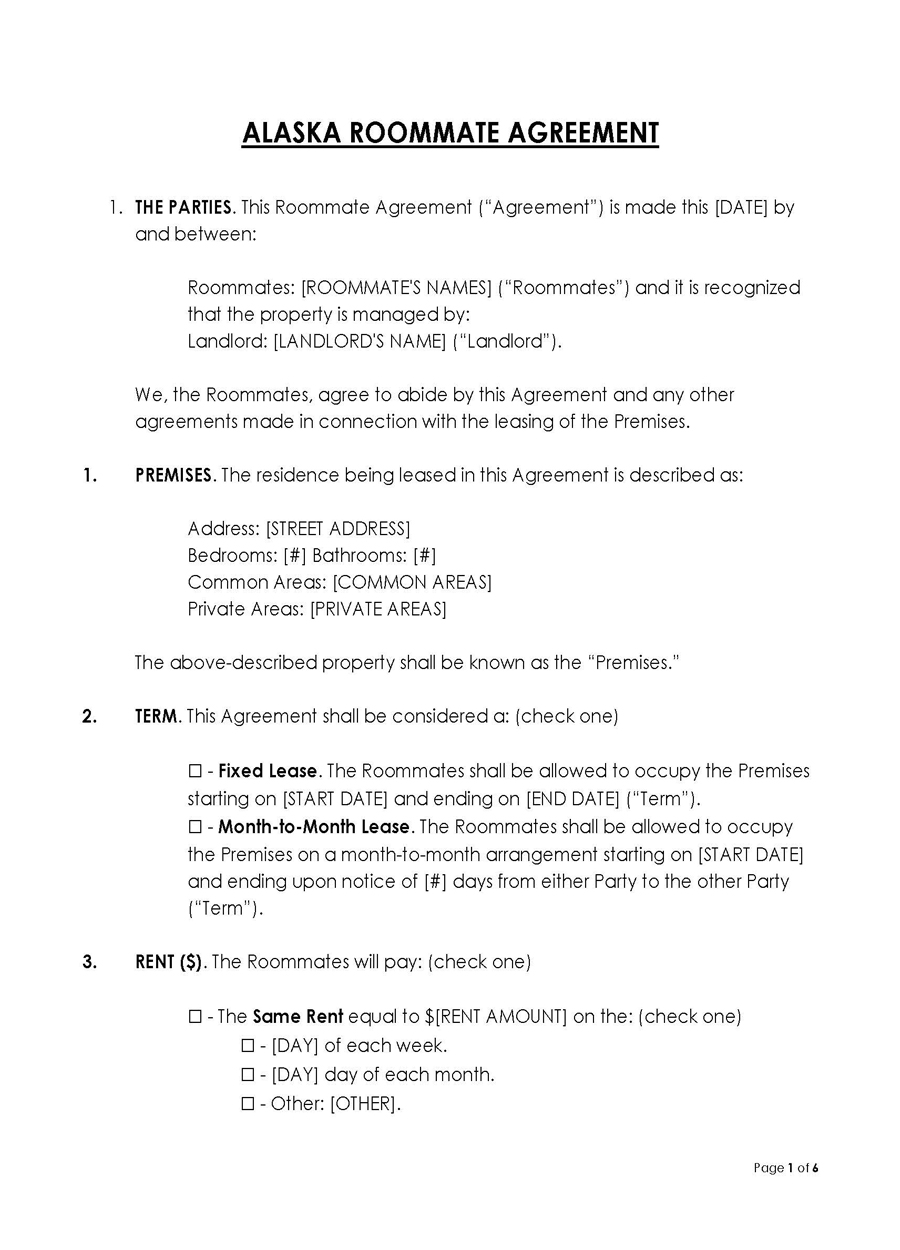
A room rental agreement is typically drawn up for tenants living in a shared space. This is common in houses or apartments with multiple bedrooms and stipulates how certain expenses will be shared. Besides listing the responsibilities for different bills, rent, and other economic conditions, it should also list specific living rules.
EXAMPLE
It may detail the process for inviting guests, appropriate procedures for using common areas, and standard cleaning practices.
Standard lease agreement
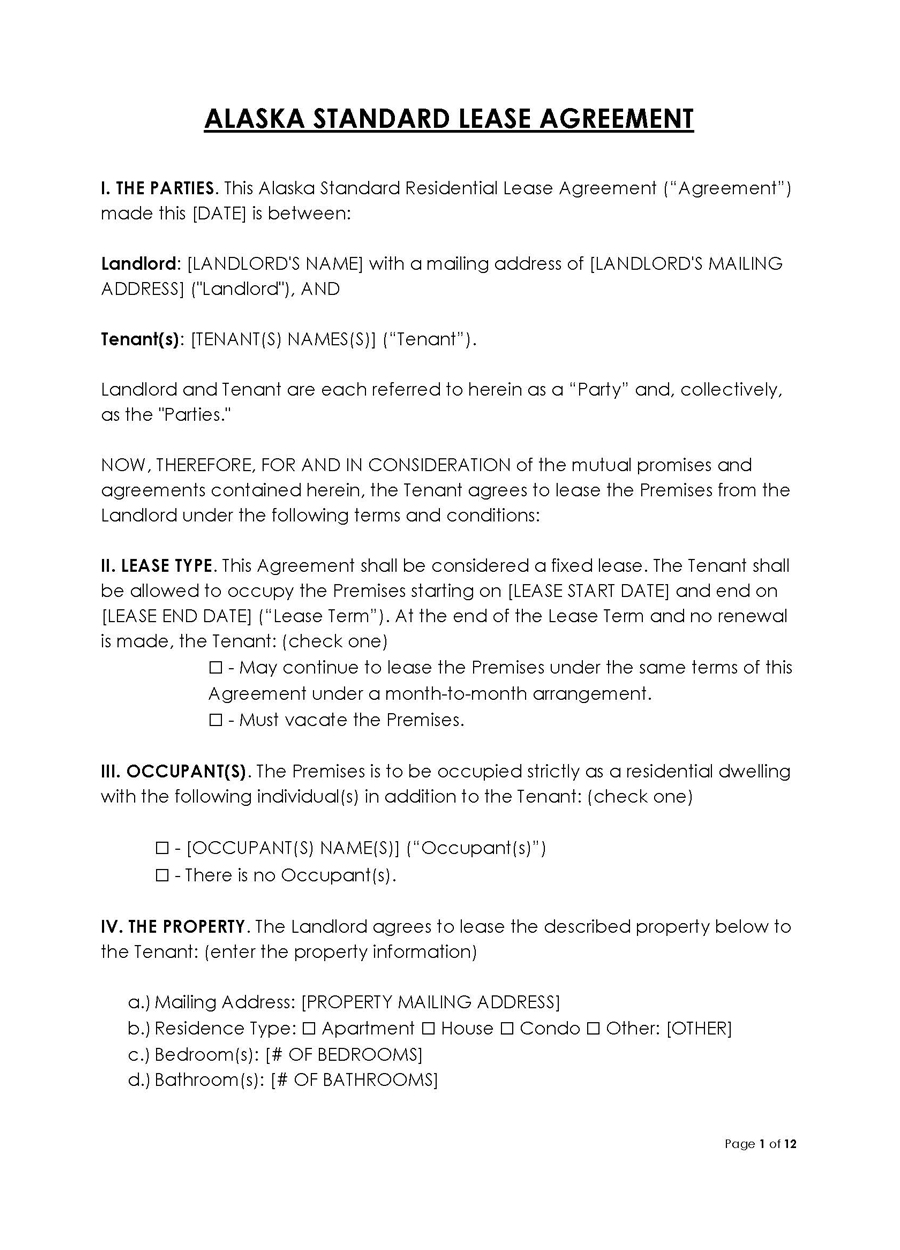
A lease agreement in Alaska is a formal contract that stipulates all the conditions of a tenant taking temporary possession of a landlord’s property. This binding contract will detail all the related conditions and begin as soon as the tenant moves in, pays, and signs the agreement. The lease may not be changed during its adequate time, and steps are taken to prevent any last-minute changes that may negatively affect either party. The contract must detail the period of the tenant’s duration at the residence and other conditions, such as the rental amount, living conditions, and the possibility to end/renew the contract. For this reason, Alaskan courts are legally able to enforce this agreement if either party takes actions that do not comply with the signed contract.
Sublease agreement
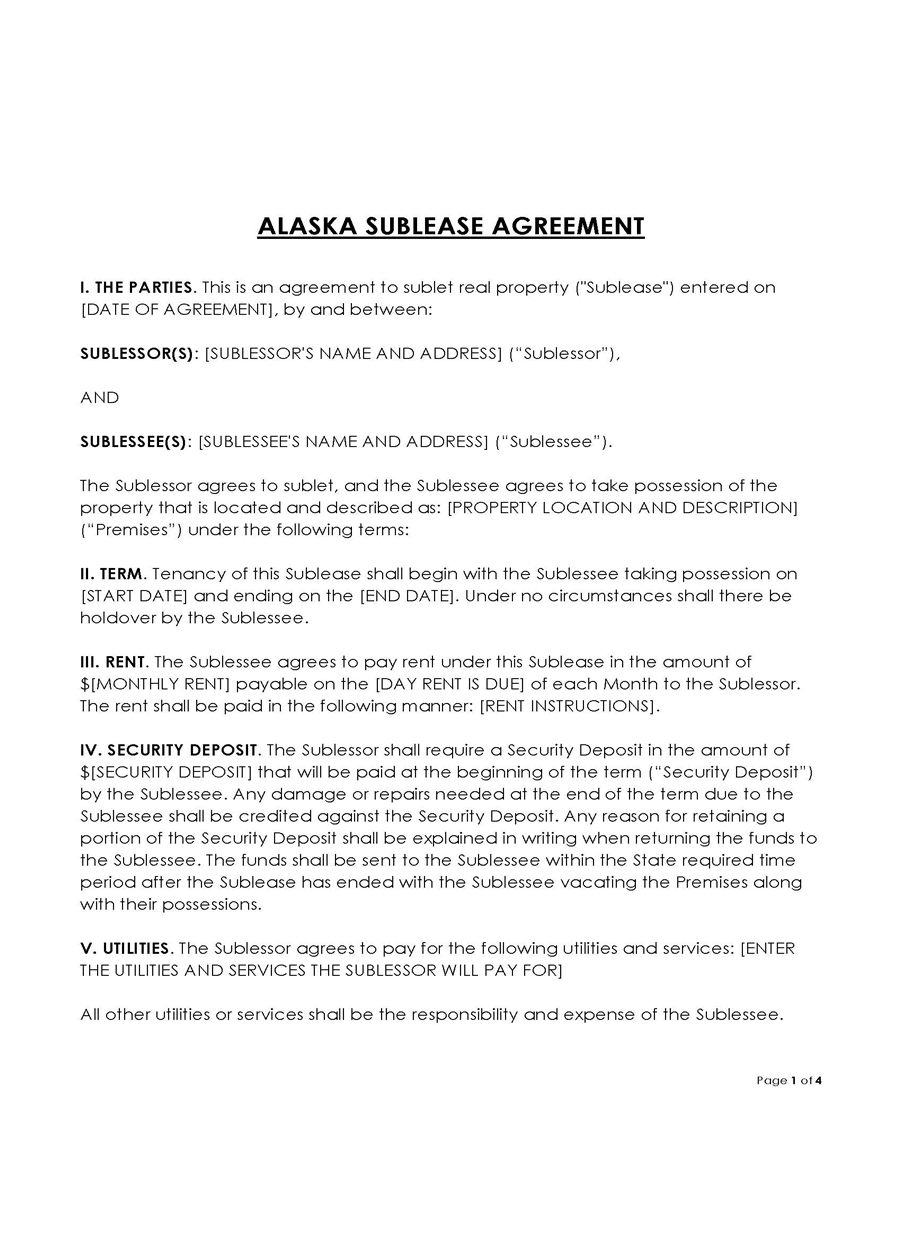
This particular agreement is a contract between a current tenant and a potential lessee who will take over the property in their place. Therefore, this document must be clearly outlined, as both parties will then be responsible for the conditions of the property and the terms listed within the agreement. Additionally, it is required that the current tenant obtain written permission from the landlord, allowing them to sublease the property. To the same effect, the new lessee must abide by the same rules listed in the original standard lease agreement that the tenant signed with the landlord.
Required Disclosures
Within the standard lease agreement in Alaska, it is legally required for several conditions to be explicitly mentioned. These details ensure that the agreement lists every possible aspect of the living arrangement so that neither party is negatively affected.
Some disclosures that must be explicitly stated are:
The landlord’s name and address
The property owner must list their full legal name and permanent address so that the tenant can contact them in the future. This guarantees that any potential legal proceedings can be efficiently delivered to the appropriate location. This information must be placed within the rental contract or delivered, in writing, to the tenant before taking possession of the property.
Tenant’s absence
In Alaska, lease agreements must specify the conditions of a tenant’s occupancy. These terms include the requirement to disclose absences to the landlord.
EXAMPLE
If the tenant is going to be away from the property for more than seven days, they must notify their landlord as soon as possible. This must be done to ensure the safety of the property.
Lead-based paint
Within the United States of America, federal law requires all landlords to notify their tenants of the possible risks of lead-based paints for any homes built before 1978. Within the state of Alaska, landlords have several responsibilities.
First, they must attach a filled-out disclosure form to the lease agreement. Then, they must also provide the tenant with a pamphlet that’s Environmental Protection Agency-approved. This pamphlet should warn future tenants of all possible dangers of lead-based paints. Finally, the landlord must provide a detailed report of all known uses of lead-based paint on the property.
Withholding security deposit
The lease agreement must also detail a landlord’s conditions without the security deposits. While it is not required for a landlord to have this option, they must explicitly state the reasons if they choose to maintain this right.
EXAMPLE
The most common example is for a landlord to withhold the security deposit if the tenant creates significant damage to the property that requires repair.
As this likely violates the lease terms, being outside of regular property use, the landlord is entitled to use the security deposit to pay for the repairs.
Marijuana use
Alaska law recommends landlords explicitly state the conditions for the use of marijuana on the property. Especially common in apartment buildings, a landlord may request a tenant avoid smoking in common areas or use marijuana in a non-smoking form. The primary concern is to avoid bothering other residents during the tenant’s stay.
Move-in checklist
A move-in checklist is a way to protect the tenant from being held accountable for previously damaged aspects of the property. The tenant should be provided with an itemized list of the condition of all home elements. Often, this checklist is signed as a separate document and then later attached to the lease agreement.
Late and returned check fees
It’s also necessary to include how late and returned checks will be handled. Often, a bounced check fee will reflect a landlord’s expenses. While there is no legal limit to these fees, they tend to be no more than 10% of the rent and should be realistic. Again, the agreement should state that these late fees may only be applied after the specified monthly rent due date.
Shared utility agreement
If multiple tenants share the same utilities in Alaska, the lease agreement must specify how they are shared and how the bill is calculated. This will give future tenants an idea of the amount they will need to pay each month.
Bed bug disclosure
If a rental property has a known history of bed bug infestations, the landlord should provide helpful information to the tenant about practical proceedings. This disclosure will inform the tenant that they are responsible for notifying the landlord of any infestations and, afterward, complying with any prevention measures the landlord is obligated to undergo.
Asbestos disclosure
Landlords must include an asbestos disclosure if their property was built before 1981. As this harmful material was previously used in construction, they should notify their tenants of proper ways to avoid any chance of causing asbestos damage.
EXAMPLE
Activities such as sanding, pounding, or any changes to the walls may disturb the fibers in asbestos and potentially cause lung damage.
For this reason, the tenants must inform the landlord if they intend to engage in any of these activities or if they find any damage to the ceilings or walls.
Mold disclosure
Landlords should also inform the tenant of any known mold issues within the rental property. This ensures that the tenant is not held responsible for any mold damages that may continue on the property in the future.
Alaska Lease Agreement Templates
How do I Write an Alaska Lease Agreement?
All Alaska lease agreements should be written to comply with all relevant state laws. Therefore, several critical components must be listed within the document to ensure it complies with the law:
- First and foremost, the legal names of the landlord and all tenants, along with their specific addresses, should be listed. This may be the property management’s company name and address rather than an individual in some cases.
- Next, the specific terms for the lease duration should be mentioned.
EXAMPLE
Whether the agreement is a month-to-month or a yearly agreement should be stated.
- In addition, the specific dates when a lease will begin and end must be stated within the document.
- Another vital piece of the rental contract is the amount of rent that must be paid. The agreement should specify the dollar amount, the date when it must be paid, an address to pay the rent, and any late fees.
- A landlord may often request multiple payments upfront before giving the property to the tenant.
EXAMPLE
Typical examples are a security deposit and the first month’s rent as an initial payment.
- Therefore, the lease agreement must outline how those first two amounts must be paid and whether the security deposit will be refundable.
- While residential agreements must state the names of all occupants, including minors, commercial agreements should list who has the right to use the property. These terms should also be adequately reflected in the rent payments.
- Other essential factors to consider in the document are the utilities, which may or may not be included in the rent payment.
- Additionally, information such as parking conditions should be mentioned.
EXAMPLE
If a tenant is designated a reserved spot, that should be mentioned.
- Next, anything related to specific furnishings included within the property should be mentioned.
EXAMPLE
If a tenant brings their appliances, the landlord should specify which appliances are allowed or not.
- Afterward, any specific terms regarding the property’s abandonment conditions should be mentioned.
EXAMPLE
How a tenant or landlord should appropriately give notices to each other, any potential eviction proceedings, and any additional terms that both parties agree to
- Finally, the document must be signed and dated by everyone involved.
Security deposit
In a lease agreement in Alaska, a landlord can only charge up to 2 months’ rent as a security deposit. This is delegated by Alaska law § 34.03.070(a). However, if the rent is more than $2,000, this is no longer applicable.
The security deposit should be returned to the tenant within 14 days of abandoning the property if the tenant leaves on the agreed-upon date. However, if the tenant does not leave by the stipulated date, the landlord has 30 days to return the security deposit, as noted by § 34.03.070(g).
Right to enter
If a landlord chooses to enter the property, they must provide the tenants with a minimum of 24 hours’ notice. Otherwise, they are not legally allowed to enter the premises. This legal obligation is noted by Alaska law § 34.03.140.
Late fees
There is no maximum limit on the late fees applied to improper rental payments within Alaska. However, they must be explicitly stated within the rental agreement and aligned with Alaska’s usury rate.
For checks that have bounced, a landlord can only charge up to $30 each time it happens. This is stipulated by Alaska law § 09.68.115(a)(2).
Rent due
The rent due date can vary depending on each specific lease agreement. However, the contract must specify exactly which day the rent will be due. If a tenant fails to provide rent payment, the landlord can give a tenant a 7-day notice to either pay the rent (and late fee) or vacate the premises.
Frequently Asked Question
In Alaska, the maximum time that can be established is one year. After one year, a tenant and landlord may decide to renew the contract, but it is not an obligation.
Alaska’s residential leases may be shorter, such as month-to-month agreements, but they may not exceed one year in duration.
When the tenant has made the initial payment, the landlord has accepted it, and at least one of the two parties has signed the agreement, the lease becomes legally binding. This is to prevent any last-minute changes and protect both parties.
A tenant and a landlord may decide that notarizing a lease may be helpful. However, it is not required to do so. This contract becomes legally binding upon meeting the conditions described above, with or without notarization.
Unless explicitly stated otherwise in the rental agreement, it is perfectly acceptable for a lease to automatically renew in the state of Alaska. With approval from both parties, the lease can automatically renew for the same amount of time as the original document, typically one year.
